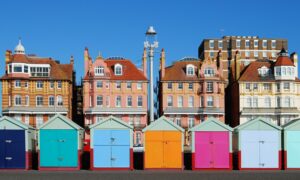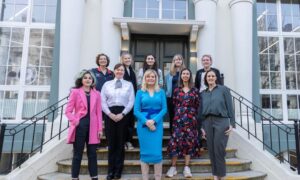While walking to work last Friday, I paused next to the new statue on Hove Plinth. This intriguing piece of artwork by Brighton based sculptor Pierre Diamantopoulo, entitled ‘The Flight of the Langoustine’, was inspired by a “mangled” lobster pot which, in the words of its finder, “translated itself into a wider story of human exodus and release – a dash for freedom”.
As I walked on towards school, I reflected on the concept of freedom and its uneasy relationship with school and education. A few weeks ago, I had the pleasure of travelling to one of our sister schools, Portsmouth High, to watch Year 11 student, Immie, represent Brighton Girls in the regional heat of the GDST Public Speaking Competition. Her topic was freedom, and she started her speech with a wry analysis of her current, fettered existence: chained to a desk, a slave to revision notes; no longer Immie, but Candidate 5432.
As I arrived at work, still pondering this story of human exodus and release, I was delighted to see a calendar reminder pop up on my phone: 9.10. Lesson Observation. Year 10 Design and Innovation. Off I went. What followed was a masterclass in creative freedom. The lesson featured several open-ended tasks involving pieces of cardboard and dowling; sketching against the clock; testing ideas. There was even a verbal explanation from an animated gif of Snoop Dog. No mention of assessment objectives here.
The lesson was a follow-up to a trip to the world-famous, Worthing-based design company, Bower and Wilkins. The focus of the visit, and subsequent lesson, was not a broken lobster pot washed up by the sea but (on a similar theme), a nautilus shell, the inspiration for the industry-leading Nautilus speaker.
It was inspiring and reassuring to see the real-world application of creativity occurring within the curriculum. While a proportion of the learning will eventually be measured by assessments, these students were gaining an insight into how to create prototypes, how to embrace creative freedom, and being inspired from those who have devoted their careers to the pursuit of design excellence.
Of course, there are other ways to effect a dash for freedom in school – co-curricular and super-curricular activities offer a means of escape. In assembly on Monday, I gave students a brief glimpse of the World Economic Forum’s Future of Work report as a preface to two brilliant student presentations: one from our Cafe Enterprise team; one from members of our Sixth Form LEAD team. We are well-versed in the words of wisdom drawn from the WEF’s future skills analysis, and many will be familiar: creativity, originality and initiative; leadership and special influence; resilience, stress tolerance and flexibility; complex problem-solving.
What was great about Monday’s assembly was that, having said a few words, the students took the stage and demonstrated these skills admirably.
In its inaugural project, our Cafe Enterprise Scheme launched two values-inspired tea blends in partnership with Bird & Blend. It is no coincidence that we chose Bird & Blend to help us hone our students’ entrepreneurial skills – they are one of the most successful Brighton start-ups. In the real world, they are the real deal.
Also benefiting from the business world on our doorstep, our LEAD team has, this year, chosen a city-based scheme. LEAD is the GDST’s answer to Young Enterprise – in a scheme accredited by the London School of Economics, students work together to launch a business, pitting themselves against fellow entrepreneurs from sister GDST schools. This year, the Brighton Girls LEAD team has launched Slice of Brighton – a brilliant concept that brings recipes from local restaurants together for the benefit of those who either cannot afford to, or choose not to, eat out. It’s civic minded, it is well-conceived, and so far it is very well executed. You will be hearing more about Slice of Brighton over the coming weeks.
So, life within the lobster-pot of the current education system is not as restrictive as it sometimes seems. Like the figures on top of the Hove plinth, our students are keen to explore what lies beyond, and, based on my DT experience and the response in assembly, each dash for freedom is not only encouraged but is met with applause.


